Jet Negative Thrust by Sucking???
By Nyle Steiner K7NS 18 Aug 2003.
The issue has been raised as to whether forward thrust can be obtained by sucking in through the front instead of blowing out the back. Feynman talks about a water sprinkler that spins from water shooting out its ends but does not spin if it is submerged in water and water is sucked into it (Search google with the words - Feynman water sprinkler).
From experiments that I have done and described below, there appears to be a very simple rule. When you blow out a tube, you get positive thrust; when you suck in through a tube, you get very little or no negative thrust at all in the opposite direction. The amount of negative sucking thrust that I could observe from my experiments, was essentially zero. My thrust measuring capability however, was not sophisticated enough to make very fine measurements.
One of my friends who is a master degree research physicist, also found this experiment to be very intriguing.
This is why the pop pop boat can produce thrust. It repeatedly pushes water out a tube and sucks it back in again. It gets its thrust every time the water is pushed out but gets essentially zero negative thrust when the water is sucked back in.
Ducted Fan and U Tube Construction.
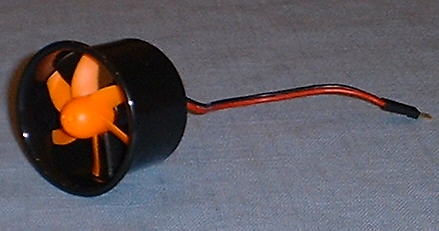
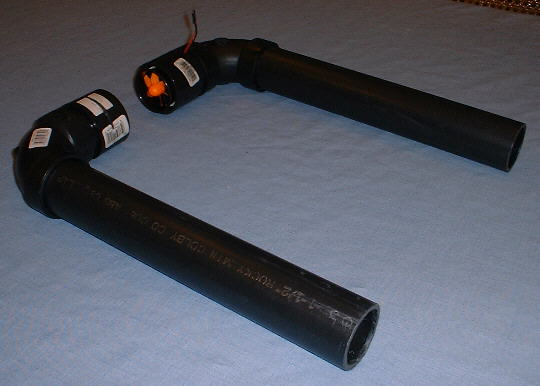
U tube construction with electric ducted fan in upper picture. The tubing is 1 1/2" abs pipe. The long ends are 12" in length. The ducted fan is EDF-40H and is sold by GWS.
I decided to build a U shaped tube with a ducted fan in the middle. All air that blows out one end must be sucked in from the opposite end. The motor was run from two series lithium ion cells taped to the side of the tube. The tube with the ducted fan was suspended from the ceiling with two 5' 4" strings near a flat surface that could be marked to show amounts of deflection from thrust.
By having both ends face the same direction, any forward thrust observed would indicate that the blowing end was pushing more than the sucking end was pulling. This turned out indeed to be the case.
U Tube Jet.
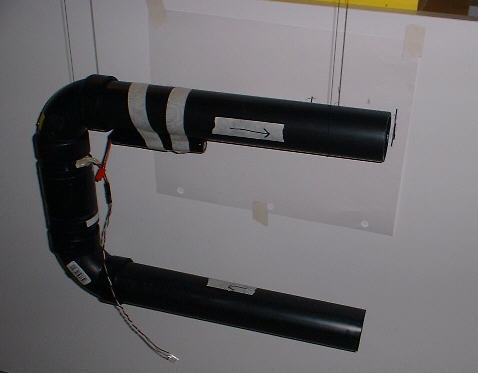
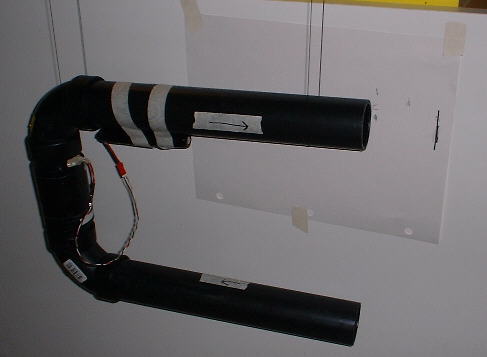
Left, the U Tube is hanging idle. Note mark by end of tube. Right, thrust is clearly shown by deflection away from the mark. Positive thrust at the blowing end is not cancelled by negative thrust at the sucking end.
What is the difference in thrust when the intake is facing forward instead of backward?
The ducted fan was later mounted at the intake end of the tube as shown in the pictures below. Deflections were observed with the intake facing toward the back and with the intake facing forward. It turns out that no significant difference in thrust was observed. In fact, in at least one instance of observing closely with another person present, the thrust (deflection)surprizingly, was slightly greater when the intake was facing backward (same direction as the output end). See pictures below.
Comparison of thrust with intake forward and backwards.
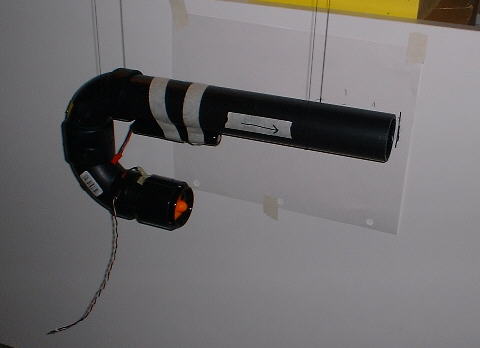
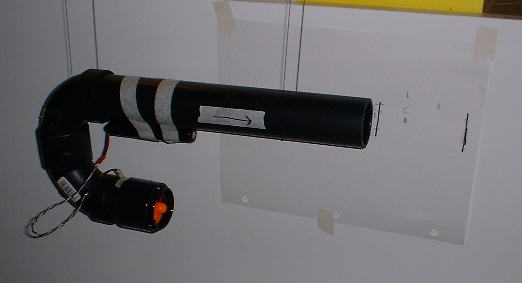
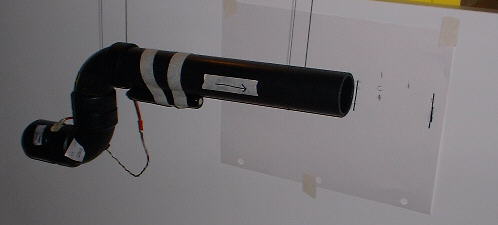
First picture, jet is idle. Second picture, jet is running with intake backwards. Third picture, jet is running with intake forward. Casual observation shows thrust (deflection) to be essentially the same in both cases.
How much negative thrust when the output end faces downward?
So far, we have been looking at the results of the intake negative thrust working against the output positive thrust. With the output facing straight down, it's effect is completely removed and any thrust or deflection sideways to the right would be an indication of negative thrust from the intake. The result in this case; no negative thrust or deflection was observed. See pictures below. Much thrust was observed when the ducted fan was reversed making the end pointing down the input and the horizontal pipe the output.
Effect of sucking input alone with output facing downward.
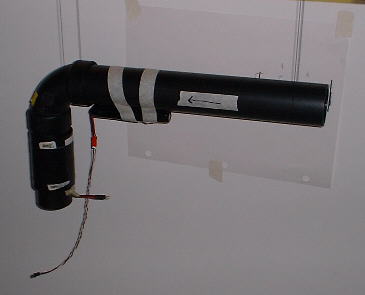
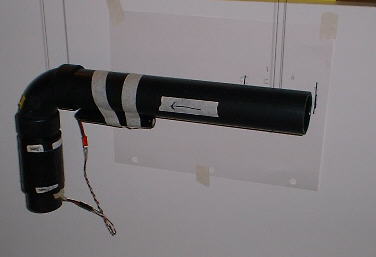
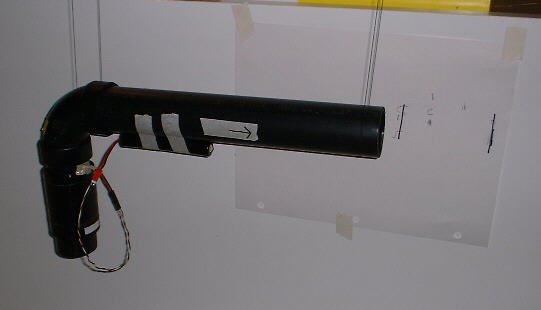
First picture, jet is idle. Second picture, jet is sucking into horizontal pipe but no observable negative thrust (deflection). Third picture, Ducted fan has been reversed and jet is blowing out horizontal pipe. Much positive thrust (deflection) is observed.
Same results were observed using a plastic tube hanging from a syringe.

With tube hanging and the syringe held in a steady position, much thrust was observed when the piston was pushed into the syringe. No noticable tube movement was observed when the piston was pulled.
The same results are observed by filling the syringe and tube with water and putting the tube under water. I did notice with water that there is a small (fraction of a second) momentary deflection of the tube when the piston is first pulled. After that, the tube appears to have no movement at all. This effect probably has something to do with initially getting the water in motion. When the piston is pushed, the tube moves energetically as long as water is being pushed through it.
My first erroneous impression, when reading about the Feynman sprinkler was that a high pressure can be pushed out; but, only one atmosphere can be sucked in, therefore much more thrust can be produced by pushing air out the tube. This is not the case as I could observe thrust by blowing my breath through the plastic tube and I know that I can not come even close to producing one atmosphere of pressure with my breath. I was able to suck much more pressure with the syringe than I could ever blow. My blowing produced much more thrust or movement than the essentially zero that I could get by pulling on the piston of the syringe.
Another explanation (which I find inadequate) for this lack of negative thrust when sucking in is as follows. When air or water is sucked into a tube, it enters from all directions. When air or water is blown out a tube, it shoots out in a concentrated stream in one direction. One would expect that even though air or water is coming in from all directions, there would still be a percentage coming straight in that would at least create a lesser but observable amount of negative thrust. With this experiment we are observing zero negative thrust.
I do not claim to have a better explanation for these observations but would suggest that the lack of negative thrust from the intake may be because air or water can flow into the intake so readily that a lower pressure outside the intake can not form easily. There is no pressure differential between the intake and the outside air or water. Air will always tend to expand into any sucking input and maintain atmospheric pressure. No thrust is produced because there is no pressure differential. Imagine trying to pull yourself forward by pulling on a large compressed spring that is expanding toward you. When a piece of flat cardboard is held very near the intake however, negative thrust is finally observed and the tube pulls toward the cardboard. This may be because the cardboard impedes the air flow into the area very near the end of the tube and a lower pressure now forms between the intake and the cardboard. Imagine the intake just fitting inside a closed cylinder. Lower pressure would certainly form inside the cylinder and the intake tube would thrust itself into the cylinder. One might wonder if in this experiment, a much greater velocity of air flow might produce a more observable amount of negative thrust.
When blowing out, there is a definite pressure differential between the output and the outside. This would create positive thrust.











